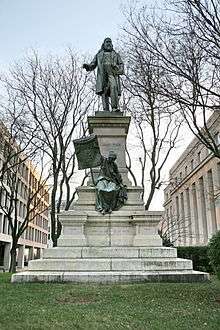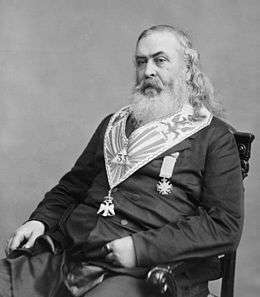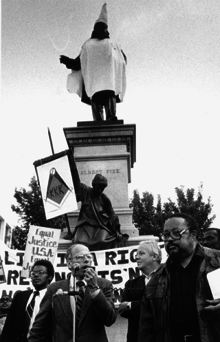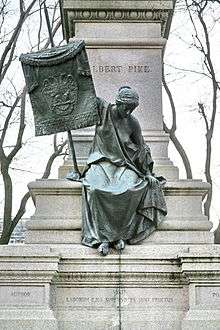Brigadier General Albert Pike
 | |
| Coordinates |
38°53′41″N 77°00′57″W / 38.8946°N 77.0157°WCoordinates: 38°53′41″N 77°00′57″W / 38.8946°N 77.0157°W |
|---|---|
|
Brigadier General Albert Pike | |
| Part of | Civil War Monuments in Washington, D.C. |
| NRHP Reference # | 78000257[1] |
| Added to NRHP | September 20, 1978[2] |
| Location | 3rd and D Streets NW, Washington, D.C., United States |
| Designer |
Gaetano Trentanove (sculptor) Washington Granite Monumental Company (fabricator) Fonderia Galli (founder) |
| Material |
bronze (sculpture) granite (base) |
| Height |
11 feet (3.4 m) (sculpture) 17.1 feet (5.2 m) (base width) 17.2 feet (5.2 m) (base height) |
| Opening date | October 23, 1901 |
| Dedicated to | Albert Pike |
Brigadier General Albert Pike is a public artwork in Washington, D.C. honoring Albert Pike (1809–1891), a poet, lawyer, soldier, and influential figure in the Scottish Rite of freemasonry. The memorial is sited near the corner of 3rd and D Streets NW in the Judiciary Square neighborhood. The memorial's two bronze figures were sculpted by Gaetano Trentanove, an Italian-American artist responsible for another Washington, D.C. sculptural landmark, the Daniel Webster Memorial. The dedication ceremony in 1901 was attended by thousands of Masons who marched in a celebratory parade.
The Pike memorial is the only outdoor sculpture in Washington, D.C. honoring a Confederate general. Though Pike is depicted as a Mason, not a soldier, the memorial has often stirred controversy. The memorial is one of 18 Civil War monuments in Washington, D.C., which were collectively listed on the National Register of Historic Places in 1978. The memorial is owned and maintained by the National Park Service, a federal agency of the Interior Department.
History
Background
Albert Pike (1809–1891) was a Massachusetts native who became a schoolteacher and frontiersman before settling in Arkansas. There he began teaching again and continued to write poetry, a lifelong passion. His letters to local newspapers led to a job offer as editor for the Arkansas Advocate, a newspaper in Little Rock affiliated with the Whig Party. Pike later became a successful lawyer specializing in Native American claims against the U.S. government. He served as a captain in the Mexican–American War and resumed his legal practice following the war. In the 1850s, Pike switched his allegiance to the Know Nothing Party due to the Whig Party's reluctance to embrace slavery and sided with the Confederacy when Southern states seceded from the United States in 1861. During the Civil War, Pike's knowledge of Native Americans led to him being commissioned a brigadier general in the Confederate Army. He assembled an Indian cavalry loyal to the Confederacy and led them in battle at Pea Ridge, where his poor leadership and inability to keep the cavalry engaged with the enemy was a contributing factor to the Confederate's loss. Alleged atrocities committed by his troops include the scalping of captured enemy combatants. A few months after the battle, Pike resigned from the army and resumed practicing law. Following the war, Pike settled in Memphis, Tennessee, where it was rumored he became involved with the Ku Klux Klan (KKK), though no definitive evidence proves his relationship with the organization.[3][4][5]

Around 1870 he moved to Washington, D.C. to practice law and continue serving as Sovereign Grand Commander (SGC) of the Washington-based Supreme Council, Southern Jurisdiction (SCJC), one of two jurisdictions in the Scottish Rite. Pike had become a Mason in 1850 and quickly rose up its ranks, becoming the SGC in 1859. He rewrote and interpreted Masonic rituals and compiled the Southern Jurisdiction's first philosophical document, Morals and Dogma of the Ancient and Accepted Scottish Rite of Freemasonry, an influential book in the organization. Pike continued serving as SGC until his death in 1891.[4] Pike once stated "When I am dead, I wish my monument to be builded only in the hearts and memories of my brethren of the Ancient and Accepted Rite", but a few years after his death, Masons began plans for a monument in the nation's capital.[3]
The SCJC chose Italian-American artist Gaetano Trentanove to sculpt the memorial. Trentanove was an acquaintance of Pike and had recently received praise for his sculpture of Jacques Marquette housed in the National Statuary Hall Collection. While Trentanove was working on the commission, Masons lobbied members of Congress for public land in Washington, D.C. where the monument could be placed.[3] When members of the Grand Army of the Republic (GAR), a fraternal organization of Union veterans, became aware of plans for a public memorial to be erected in Washington, D.C. in honor of a Confederate general, they contacted congressmen and told them it would be a disgrace to the memories of all Union soldiers.[3][6] Nevertheless, on April 9, 1898, members of Congress approved the memorial after Masons assured them it would depict Pike as a civilian, not a soldier.[3][7]
Excavation for the memorial site took place in the summer of 1899 and on July 4, 1900, the cornerstone was laid.[8][9] Prior to the cornerstone ceremony, several members of the SCJC, including Third Assistant Secretary of State Thomas W. Cridler, gathered at the House of the Temple at 433 3rd Street NW (current site of the Tax Court Building),[10] where Pike had lived, to reminisce.[9][11] The men signed a parchment noting the date and who was in attendance. At the ceremony, the parchment was enclosed in a bottle and placed in an opening of the memorial's foundation.[9] The total cost of the memorial was $15,000, raised by members of the SCJC.[12] Fabrication was carried out by the Washington Granite Monumental Company and the sculptures founded by Fonderia Galli.[7]
Dedication

The dedication ceremony on October 23, 1901, was planned to coincide with the centennial anniversary of the SCJC.[11] At 2 P.M., members of the Grand Lodge of the Masons of the District of Columbia led by Grand Master Harry Standiford marched from the Masonic Temple at 9th and F Streets NW to the House of the Temple where they joined thousands of Masons taking part in the parade.[3][13] The parade ended at the memorial site, on a triangular lot bordered by 3rd Street, D Street, and Indiana Avenue NW. A large temporary stand for invited guests and ceremony participants was built at the base of the memorial.[14]
Following a musical performance by Haley's Washington Band, grand commanders of the SCJC, the Scottish Rite's Northern Jurisdiction, and Royal Order of Scotland all released the halyard holding the U.S. flag that covered the memorial. This was followed by loud cheers from the crowd and a prayer given by Masonic chaplain Charles Alvin Smith.[13][14] Frederick Webber, secretary general of the SCJC, then gave a speech and formally presented the memorial to the American people:
I am here to represent the Supreme Council, and in its name to present to the government of the United States this statue. It will long stand as a loving tribute from his brethren of the Ancient and Accepted Scottish Rite of Freemasonry.— Frederick Webber, Evening Star, October 23, 1901[14]
President of the District Commission H. B. F. McFarland accepted the memorial on behalf of the American people:
Although Albert Pike was a soldier in the Civil War, this statue will commemorate him rather as a victor in the honorable rivalries of peace. It is well that you thus add to the comparatively small number of statues in the city of Washington which honor the victories of peace rather than of war.— H. B. F. McFarland, Evening Star, October 23, 1901[14]
After additional music was performed by the band, a benediction was given and the ceremony concluded.[14] Throughout the ceremony, Pike was portrayed as a kind poet, though there were a few references to his service as a Confederate general.[3]
Later history
For many years, members of the United Daughters of the Confederacy would hold ceremonies at the site on Pike's birthday and Masons would decorate the memorial, though the latter still happens on occasion.[3] The memorial was removed in 1972 during construction of Interstate 395 and reinstalled in September 1977 near its former site.[12][15] The memorial is one of 18 Civil War monuments in Washington, D.C., which were collectively listed on the National Register of Historic Places on September 20, 1978, and the District of Columbia Inventory of Historic Sites on March 3, 1979.[2] It is also designated a contributing property to the Pennsylvania Avenue National Historic Site, established on September 30, 1965.[15] In 1993, the memorial was surveyed by the Smithsonian Institution as part of its Save Outdoor Sculpture! program and it was deemed "well maintained."[7] The memorial is owned and maintained by the National Park Service, a federal agency of the Interior Department.[7]
Reception

Pike's memorial has often stirred controversy throughout its history, beginning with the GAR's lobbying efforts against its erection to protesters arguing it honors a traitor and alleged racist. Starting in the 1990s, there was renewed interest in removing the statue. In late 1992, members of the LaRouche movement, including civil rights activist and Lyndon LaRouche's vice presidential candidate James Bevel, began a series of protests demanding the memorial be removed, citing Pike's alleged links with the KKK. During one such event, LaRouche supporters draped Pike's statue with a KKK pointed hat and gown.[16] Bevel stated: "One way or the other, this statue is coming down. Either the statue will be taken down gracefully or it will be torn down." The protesters sought a congressional resolution to have the statue removed and replaced with a monument inscribed with the Declaration of Independence.[17] Historian and LaRouche activist Anton Chaitkin called the statue a "monument to terrorism" and members of the Council of the District of Columbia petitioned to have the statue removed.[18][19] Michael Farquhar, a former writer and editor at The Washington Post, called Pike a "blustering blowhard, a feeble poet, a laughable hypocrite, a shameless jingoist, a notoriously insubordinate military officer, and yes, a bigot with genocidal inclinations."[19] John W. Boettjer, then managing editor of the Scottish Rite Journal, wrote a rebuttal op-ed in The Washington Post in defense of the memorial and pointed out that only an Act of Congress could result in the statue's removal. He stated: "[Pike] received a full pardon from the federal government for his service in the Civil War as a Confederate general. There is not a jot of reliable proof that Albert Pike was ever a member, much less an officer, of the Klan." Boettjer also claimed a LaRouche video promised the Middle East conflict would be solved and World War III averted if the statue was removed.[20] The weekly protests by LaRouche supporters continued into 1993. That year Bevel and Chaitkin were convicted of "unlawful statue climbing" and sentenced to one week in jail.[21]
There was continued criticism of the memorial in the 1990s and 2000s. John F. Doyle, a retired judge of the Superior Court of the District of Columbia, said Pike was responsible for Native American casualties during the Civil War and their subsequent loss of land.[10] Journalist and author Richard G. Zimmerman called Pike's statue a "poor choice for a pedestal" and said inscriptions on the memorial noting Pike's virtues should include "bigot, indicted traitor, alleged barbarian, suspected plagiarist, jailbird."[22] C. Fred Kleinknecht, then chief executive officer of the Scottish Rite, defended Pike and said the statue was not in honor of his role as a Confederate general, but as an "advocate for Native Americans and his role as a champion of educational and social reform and for his literary accomplishments and scholarship."[23] Scottish Rite Journal managing editor S. Brent Morris has also defended the memorial and Pike's role as a Confederate officer: "We're not embarrassed in the least that he was a Confederate general...Even in 1901, I don't think the United States Congress would have approved honoring a Confederate general, so he was honored for all his other accomplishments."[24]
Design and location

The statue of Pike is the only outdoor sculpture in Washington, D.C. honoring a Confederate general, although he is dressed as a civilian, not a soldier.[24][25] It is located in Reservation 188 at the southwest corner of 3rd and D Street NW in the Judiciary Square neighborhood. It is sited between the U.S. Department of Labor's Frances Perkins Building and Metropolitan Police Department headquarters.[15]
The bronze sculpture of Pike measures 11 ft (3.4 m) high and depicts him as a Masonic leader, not a Confederate officer. He is wearing a double-breasted vest and a long coat. His right arm is extended and with the left hand he holds a book, thought to be his work Morals and Dogma of the Ancient and Accepted Scottish Rite of Freemasonry. The sculpture surmounts a granite, Beaux-Arts base that is 17.2 ft (5.2 m) tall and 17.1 ft (5.2 m) wide. On the front of the memorial (north side), a bronze sculpture representing the Goddess of Masonry rests halfway down the base. With her right hand, she holds the banner of the Scottish Rite on a staff. She is wearing a long Greek robe and facing downward, her ankles crossed and feet dangling.[7][26]
Inscriptions on the memorial include the following:[7]
- G. TRENTANOVE / FLLI GALLI FUSERO (base of Pike's sculpture)
- 33 / DEUS MEUMQUE JUS (on banner held by Goddess figure)
- ALBERT PIKE (front of upper base)
- Born December 29th, 1809. / Died April 2nd, 1891. (rear of base)
- AUTHOR - VIXIT / LABORUM EJUS SUPERTITIES SUN FRUCTUS - POET (front of lower base)
- SCHOLAR - SOLDIER (left side of lower base)
- ORATOR - JURIST (right side of lower base)
- PHILANTHROPIST - ERECTED 1901 BY THE SUPREME COUNCIL OF / THE AASR OF FREEMASONRY / FOR THE S J U.S.A. - PHILOSOPHER (rear of lower base)
See also
References
- ↑ National Park Service (2010-07-09). "National Register Information System". National Register of Historic Places. National Park Service.
- 1 2 "District of Columbia Inventory of Historic Sites" (PDF). District of Columbia Office of Planning - Historic Preservation Office. September 30, 2009. Archived from the original (PDF) on November 5, 2014. Retrieved November 26, 2015.
- 1 2 3 4 5 6 7 8 Jacob, Kathryn Allamong (1998). Testament to Union: Civil War Monuments in Washington, D.C. JHU Press: JHU Press. pp. 59–62. ISBN 9780801858611.
- 1 2 Moneyhon, Carl H. "Albert Pike (1809–1891)". Encyclopedia of Arkansas History & Culture. Central Arkansas Library System. Retrieved November 26, 2015.
- ↑ Loewen, James W. (July 1, 2015). "Why do people believe myths about the Confederacy? Because our textbooks and monuments are wrong.". The Washington Post. Retrieved November 26, 2015.
- ↑ "The Veterans Are Up In Arms". The Evening Press. May 26, 1898. Retrieved November 26, 2015.
- 1 2 3 4 5 6 "Brigadier General Albert Pike, (sculpture)". Smithsonian American Art Museum. Retrieved November 26, 2015.
- ↑ "Statue of Albert Pike". Alexandria Gazette. July 11, 1899. Retrieved November 26, 2015.
- 1 2 3 "Corner Stone in Place". Evening Star. July 4, 1900. Retrieved November 26, 2015.
- 1 2 Doyle, John F. (March 7, 1998). "General's Role Brings Indian Bloodshed, Land Loss". The Washington Post. Retrieved November 27, 2015 – via HighBeam Research. (subscription required (help)).
- 1 2 "The Scottish Rite". Evening Star. October 10, 1901. Retrieved November 26, 2015.
- 1 2 Scott, Gary (September 19, 1977). "National Register of Historic Places Inventory--Nomination Form - Civil War Monuments in Washington, D.C" (PDF). National Park Service. Retrieved November 26, 2015.
- 1 2 "Centennial Celebration". Evening Star. October 17, 1901. Retrieved November 26, 2015.
- 1 2 3 4 5 "A Centennial Day". Evening Star. October 23, 1901. Retrieved November 26, 2015.
- 1 2 3 Robinson & Associates, Inc. (August 23, 2004). "National Register of Historic Places Registration Form - Pennsylvania Avenue National Historic Site" (PDF). National Park Service. pp. 60, 153. Retrieved November 26, 2015.
- ↑ "Protesters Want Statue Removed". The Washington Post. October 8, 1992. Retrieved November 27, 2015 – via HighBeam Research. (subscription required (help)).
- ↑ "Confederate Statue Target Of Protesters". TimesDaily. Associated Press. November 30, 1992. Retrieved November 27, 2015.
- ↑ Chaitkin, Anton (April 4, 1993). "It's a Monument to Terrorism". The Washington Post. Retrieved November 27, 2015 – via HighBeam Research. (subscription required (help)).
- 1 2 Farquhar, Michael (March 14, 1993). "Pike's Pique: Why This Statue Is a Bust". The Washington Post. Retrieved November 27, 2015 – via HighBeam Research. (subscription required (help)).
- ↑ Boettjer, John W. (March 24, 1993). "No Proof Of Klan Membership". The Washington Post. Retrieved November 27, 2015 – via HighBeam Research. (subscription required (help)).
- ↑ "Judge Convicts Two Protesters Of Pike Statue". The Washington Post. April 20, 1993. Retrieved November 27, 2015 – via HighBeam Research. (subscription required (help)).
- ↑ Zimmerman, Richard G. (April 30, 2000). "Poor Choice For a Pedestal". The Washington Post. Retrieved November 27, 2015 – via HighBeam Research. (subscription required (help)).
- ↑ Kleinknecht, C. Fred (May 7, 2000). "This Man Deserves to Be on a Pedestal". The Washington Post. Retrieved November 27, 2015 – via HighBeam Research. (subscription required (help)).
- 1 2 Montgomery, David (April 12, 2011). "Hunting for the Confederacy in D.C.". The Washington Post. Retrieved November 27, 2015 – via HighBeam Research. (subscription required (help)).
- ↑ Loewen, James W. (2013). Lies Across America: What Our Historic Sites Get Wrong. New York: The New Press. ISBN 9781595586766.
- ↑ Goode, James M. (1974). The Outdoor Sculpture of Washington, D.C. Washington, D.C.: Smithsonian Institution Press. pp. 228, 413. ISBN 0-87474-149-1.
External links
-
 Media related to Albert Pike by Gaetano Trentanove at Wikimedia Commons
Media related to Albert Pike by Gaetano Trentanove at Wikimedia Commons